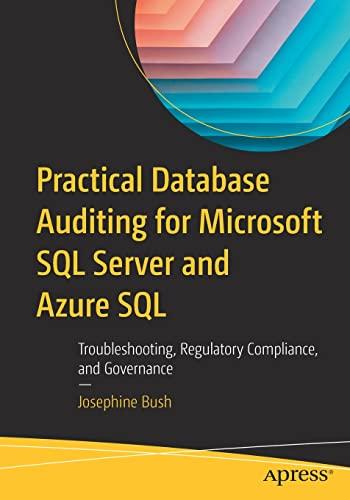Question
A rule-based expert system contains rules in its knowledge base. The rules are used to generate questions for the user. The users responses allow the
A rule-based expert system contains rules in its knowledge base. The rules are used to generate questions for the user. The users responses allow the system to provide recommendations. Suppose that you have an expert system that recommends notebook computers based on a customers needs.
Lets consider the example of selecting a notebook. Several rules can be defined for choosing between Toshiba Satellite A100 and a Dell Latitude X1.
The following are rules in the knowledge base used for making recommendation:
Rule 1
IF the primary task = word processing
AND primary usage = travel
THEN weight requirement = light
Rule 2
IF the primary task = word processing
AND primary usage = office
THEN weight requirement = dont care
Rule 3
IF budget <= 2000
AND budget > 1000
AND weight requirement = light
THEN NB model = Dell Latitude X1
Rule 4
IF budget < 1000
AND weight requirement = dont care
THEN NB model = Toshiba Satellite A100
The following is a possible consultation session using forward chaining inference mechanism:
What is your primary task to be performed on the notebook computer?
Word processing
Communications
Multimedia applications
Answer: 1 (click the first check box)
Where are you going to use the notebook most often?
In the office
While traveling
Answer: 2 (click the second check box)
What is your budget range?
Below $1K
Between $1K and $2K
Above $2K
Answer: 2 (click the second check box)
System recommendation: You should consider buying a Dell Latitude X1.
Reasons: It is light and more suitable for your word processing and travel needs and it also fits your budget.
The following is a possible consultation session using backward chaining inference mechanism:
What is your budget range?
Below $1K
Between $1K and $2K
Above $2K
Answer: 2 (click the second check box)
What is your primary task to be performed on the notebook computer?
Word processing
Communications
Multimedia applications
Answer: 1 (click the first check box)
Where are you going to use the notebook most often?
In the office
While traveling
Answer: 2 (click the second check box)
System recommendation: You should consider buying a Dell Latitude X1.
Reasons: It is light and more suitable for your word processing and travel needs and it also fits your budget.
Creating Expert Systems
In this exercise you will be developing a simple expert system to identify animals. You don't have to write any computer code. Consider yourself to be the expert with expertise to distinguish different kinds of animals.
The expert system must be able to identify and distinguish between the following animals: cheetah, giraffe, ant, wasp, vulture, bat, lion, millipede, and ant-eater.
Use following questions as aid to identify ways to distinguish above animals:
How many legs does the animal have?
Does the animal eat meat?
Does the animal have a hard outer skeleton?
Does the animal have dark spots/patches on its fur?
Can the animal fly?
Organize knowledge gained from answers to above questions into a meaningful form that allows you to reach to a recommendation. Consider organizing in forms such as tables, trees, etc.
After organizing knowledge on distinguishing animals
Develop rules for knowledge base
Develop a sample consultation session using forward chaining inference strategy that leads to identification of Lion
Develop a sample consultation session using backward chaining inference strategy that leads to identification of Giraffe
Step by Step Solution
There are 3 Steps involved in it
Step: 1

Get Instant Access to Expert-Tailored Solutions
See step-by-step solutions with expert insights and AI powered tools for academic success
Step: 2

Step: 3

Ace Your Homework with AI
Get the answers you need in no time with our AI-driven, step-by-step assistance
Get Started


